Abstract
Myotonic dystrophy (DM), an autosomal dominant neuromuscular disease, is caused by a CTG-repeat expansion, with affected individuals having > or = 50 repeats of this trinucleotide, at the DMPK locus of human chromosome 19q13.3. Severely affected individuals die early in life; the milder form of this disease reduces reproductive ability. Alleles in the normal range of CTG repeats are not as unstable as the (CTG)(> or = 50) alleles. In the DM families, anticipation and parental bias of allelic expansions have been noted. However, data on mechanism of maintenance of DM in populations are conflicting. We present a maximum-likelihood model for examining segregation distortion of CTG-repeat alleles in normal families. Analyzing 726 meiotic events in 95 nuclear families from the CEPH panel pedigrees, we find evidence of preferential transmission of larger alleles (of size < or = 29 repeats) from females (the probability of transmission of larger alleles is .565 +/- 0.03, different from .5 at P approximately equal .028). There is no evidence of segregation distortion during male meiosis. We propose a hypothesis that preferential transmission of larger CTG-repeat alleles during female meiosis can compensate for mutational contraction of repeats within the normal allelic size range, and reduced viability and fertility of affected individuals. Thus, the pool of premutant alleles at the DM locus can be maintained in populations, which can subsequently mutate to the full mutation status to give rise to DM.
Full text
PDF

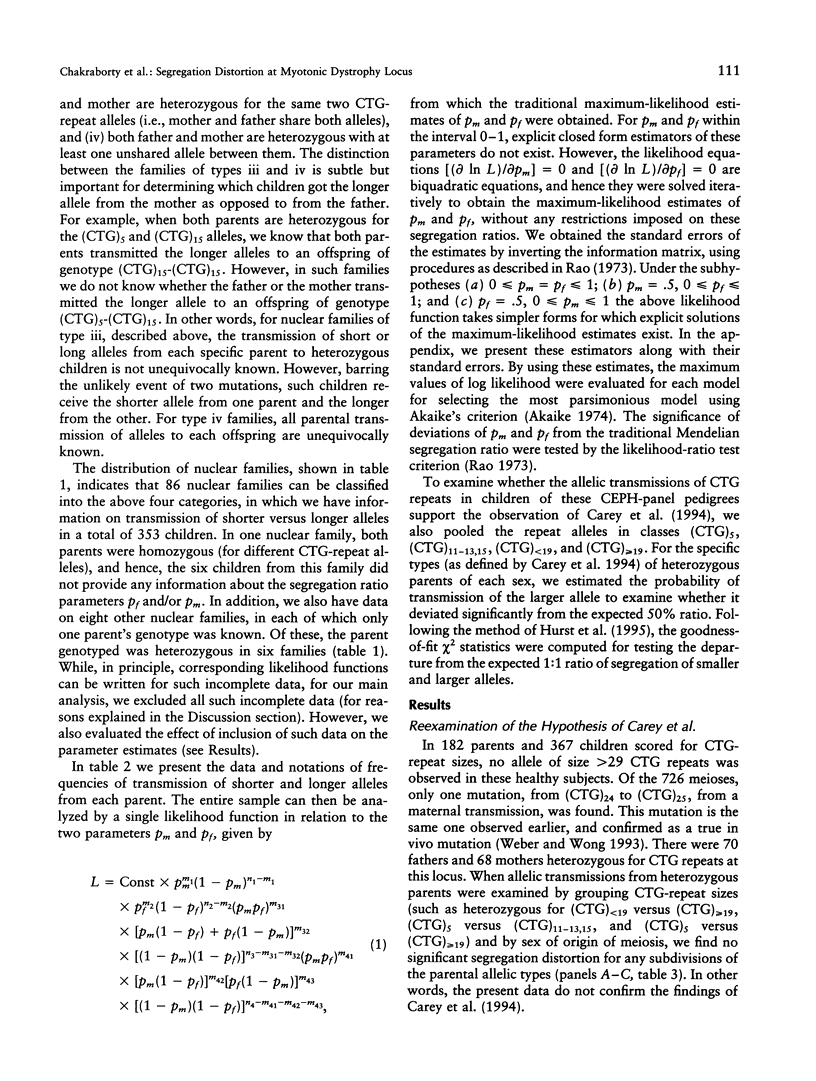

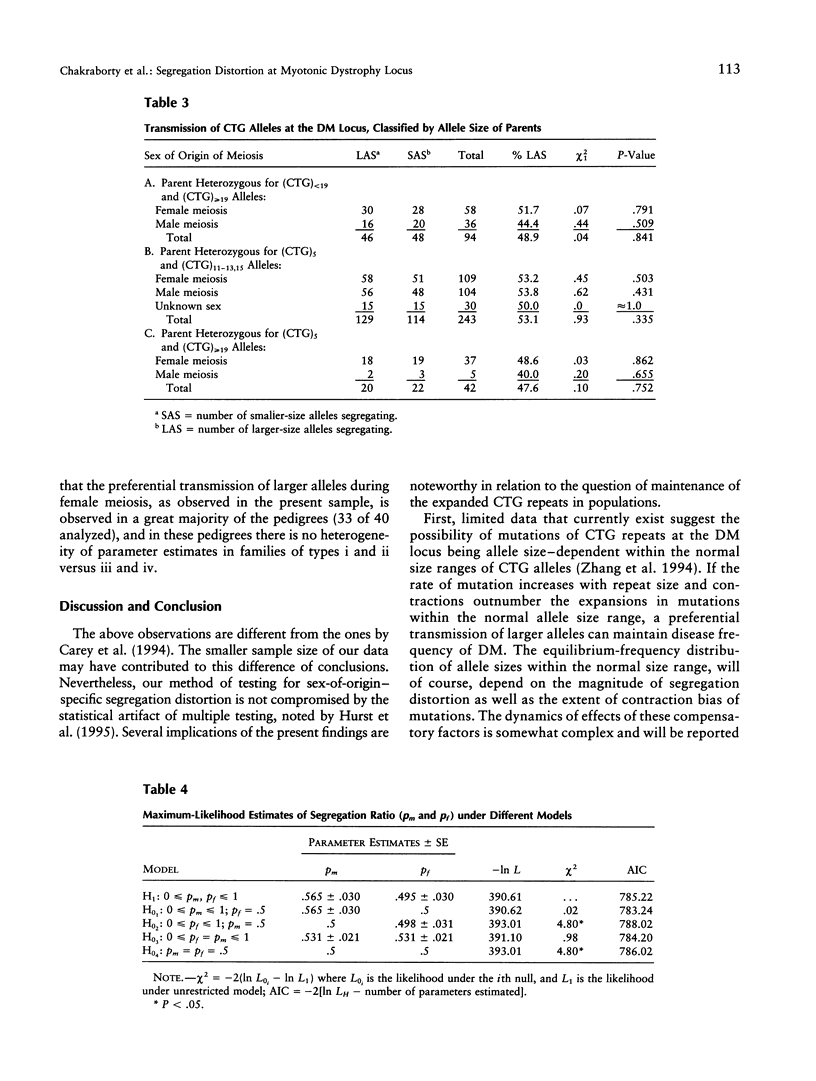
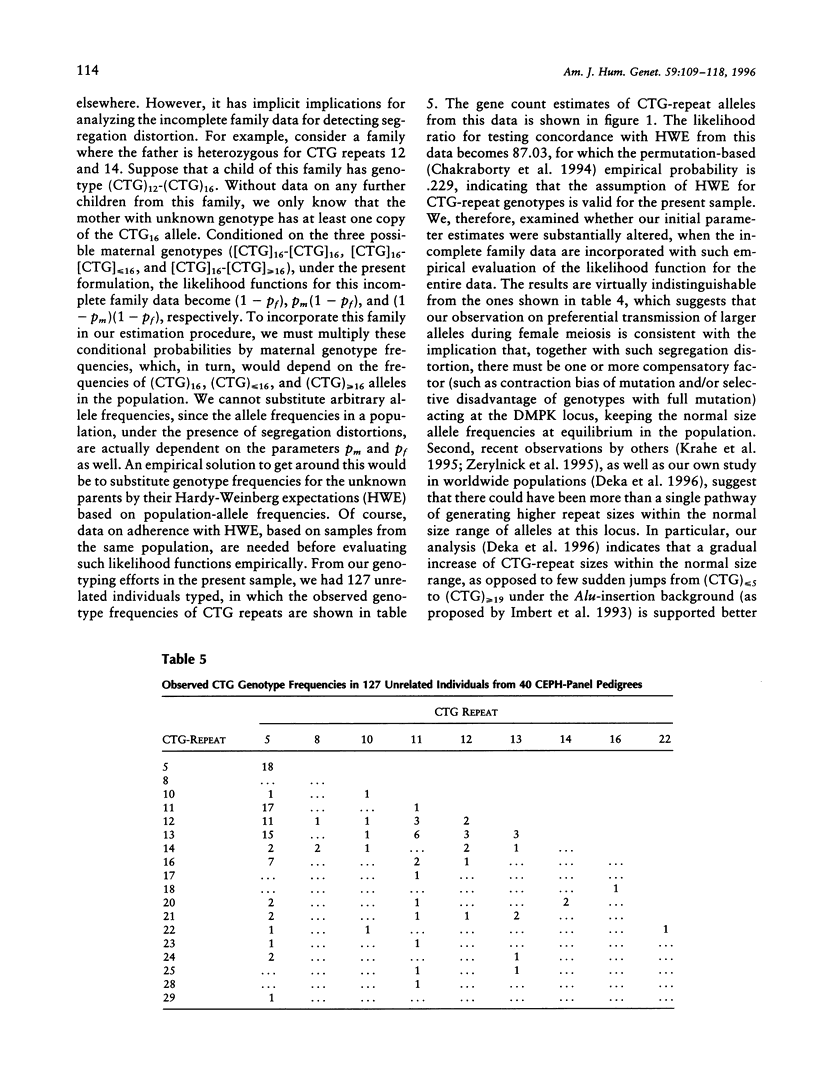


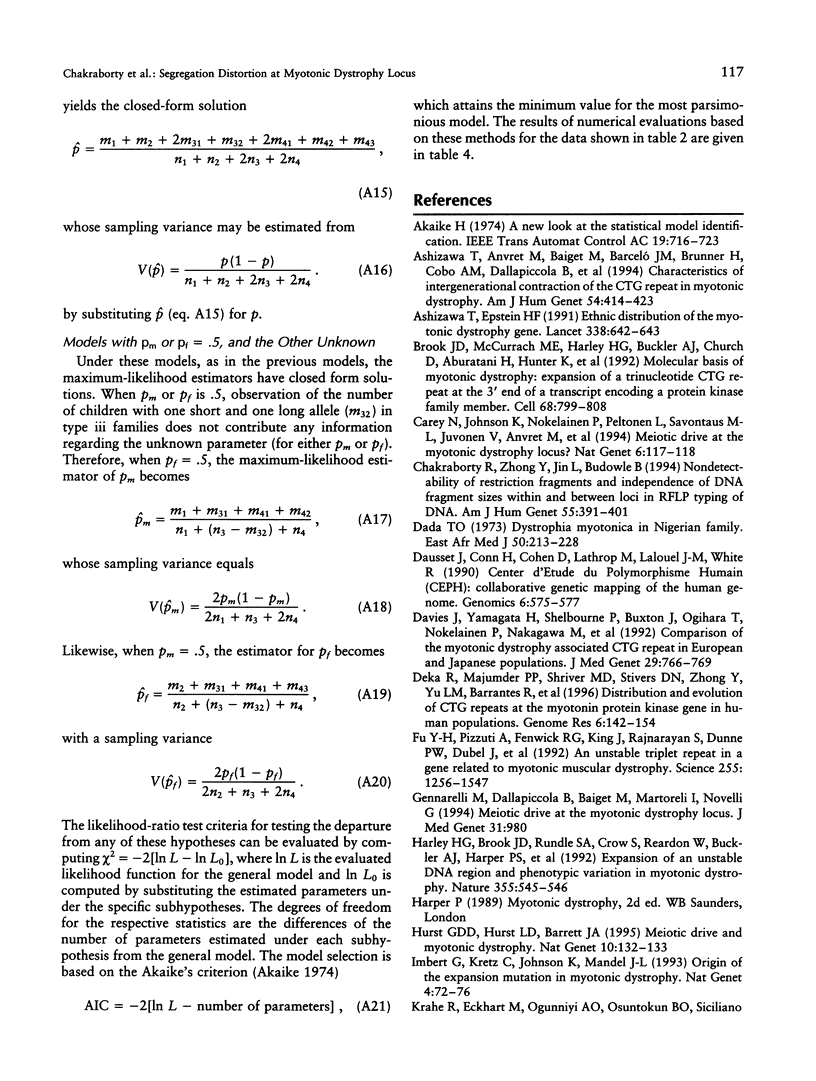
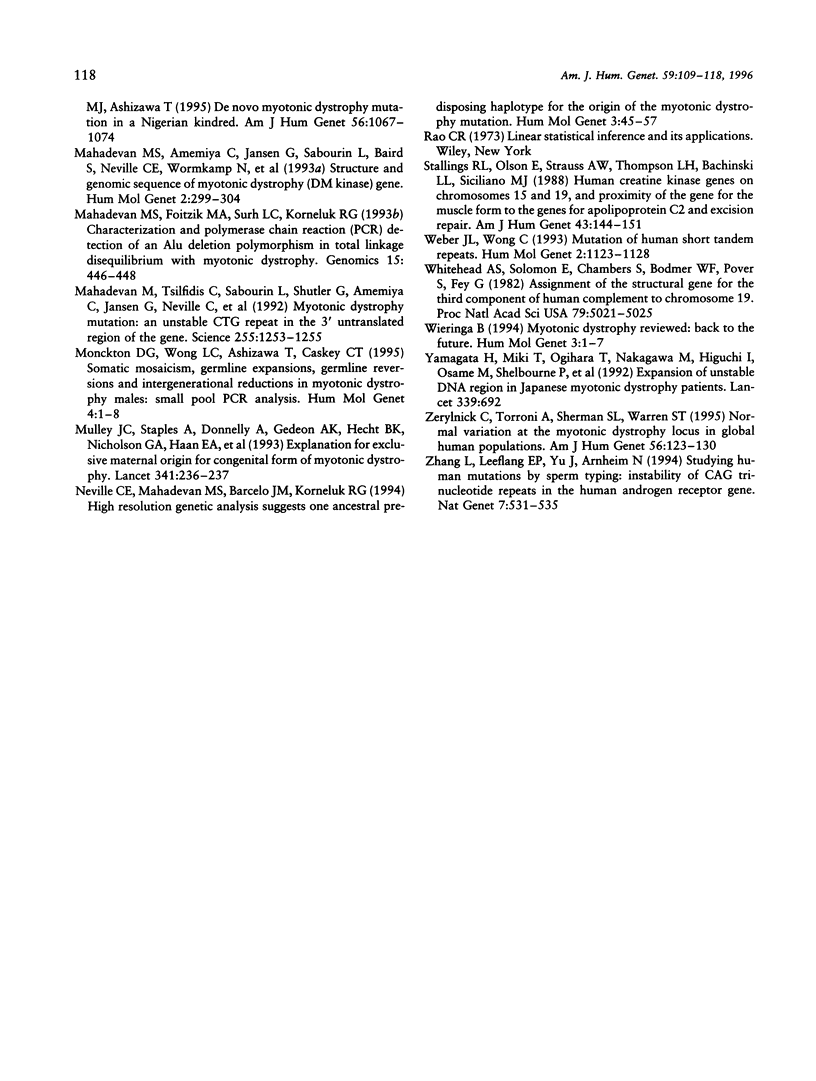
Selected References
These references are in PubMed. This may not be the complete list of references from this article.
- Ashizawa T., Anvret M., Baiget M., Barceló J. M., Brunner H., Cobo A. M., Dallapiccola B., Fenwick R. G., Jr, Grandell U., Harley H. Characteristics of intergenerational contractions of the CTG repeat in myotonic dystrophy. Am J Hum Genet. 1994 Mar;54(3):414–423. [PMC free article] [PubMed] [Google Scholar]
- Ashizawa T., Epstein H. F. Ethnic distribution of myotonic dystrophy gene. Lancet. 1991 Sep 7;338(8767):642–643. doi: 10.1016/0140-6736(91)90659-d. [DOI] [PubMed] [Google Scholar]
- Brook J. D., McCurrach M. E., Harley H. G., Buckler A. J., Church D., Aburatani H., Hunter K., Stanton V. P., Thirion J. P., Hudson T. Molecular basis of myotonic dystrophy: expansion of a trinucleotide (CTG) repeat at the 3' end of a transcript encoding a protein kinase family member. Cell. 1992 Feb 21;68(4):799–808. doi: 10.1016/0092-8674(92)90154-5. [DOI] [PubMed] [Google Scholar]
- Carey N., Johnson K., Nokelainen P., Peltonen L., Savontaus M. L., Juvonen V., Anvret M., Grandell U., Chotai K., Robertson E. Meiotic drive at the myotonic dystrophy locus? Nat Genet. 1994 Feb;6(2):117–118. doi: 10.1038/ng0294-117. [DOI] [PubMed] [Google Scholar]
- Chakraborty R., Zhong Y., Jin L., Budowle B. Nondetectability of restriction fragments and independence of DNA fragment sizes within and between loci in RFLP typing of DNA. Am J Hum Genet. 1994 Aug;55(2):391–401. [PMC free article] [PubMed] [Google Scholar]
- Dada T. O. Dystrophia myotonica in a Nigerian family. East Afr Med J. 1973 Apr;50(4):213–228. [PubMed] [Google Scholar]
- Dausset J., Cann H., Cohen D., Lathrop M., Lalouel J. M., White R. Centre d'etude du polymorphisme humain (CEPH): collaborative genetic mapping of the human genome. Genomics. 1990 Mar;6(3):575–577. doi: 10.1016/0888-7543(90)90491-c. [DOI] [PubMed] [Google Scholar]
- Davies J., Yamagata H., Shelbourne P., Buxton J., Ogihara T., Nokelainen P., Nakagawa M., Williamson R., Johnson K., Miki T. Comparison of the myotonic dystrophy associated CTG repeat in European and Japanese populations. J Med Genet. 1992 Nov;29(11):766–769. doi: 10.1136/jmg.29.11.766. [DOI] [PMC free article] [PubMed] [Google Scholar]
- Deka R., Majumder P. P., Shriver M. D., Stivers D. N., Zhong Y., Yu L. M., Barrantes R., Yin S. J., Miki T., Hundrieser J. Distribution and evolution of CTG repeats at the myotonin protein kinase gene in human populations. Genome Res. 1996 Feb;6(2):142–154. doi: 10.1101/gr.6.2.142. [DOI] [PubMed] [Google Scholar]
- Fu Y. H., Pizzuti A., Fenwick R. G., Jr, King J., Rajnarayan S., Dunne P. W., Dubel J., Nasser G. A., Ashizawa T., de Jong P. An unstable triplet repeat in a gene related to myotonic muscular dystrophy. Science. 1992 Mar 6;255(5049):1256–1258. doi: 10.1126/science.1546326. [DOI] [PubMed] [Google Scholar]
- Gennarelli M., Dallapiccola B., Baiget M., Martorell L., Novelli G. Meiotic drive at the myotonic dystrophy locus. J Med Genet. 1994 Dec;31(12):980–980. doi: 10.1136/jmg.31.12.980. [DOI] [PMC free article] [PubMed] [Google Scholar]
- Harley H. G., Brook J. D., Rundle S. A., Crow S., Reardon W., Buckler A. J., Harper P. S., Housman D. E., Shaw D. J. Expansion of an unstable DNA region and phenotypic variation in myotonic dystrophy. Nature. 1992 Feb 6;355(6360):545–546. doi: 10.1038/355545a0. [DOI] [PubMed] [Google Scholar]
- Hurst G. D., Hurst L. D., Barrett J. A. Meiotic drive and myotonic dystrophy. Nat Genet. 1995 Jun;10(2):132–133. doi: 10.1038/ng0695-132. [DOI] [PubMed] [Google Scholar]
- Imbert G., Kretz C., Johnson K., Mandel J. L. Origin of the expansion mutation in myotonic dystrophy. Nat Genet. 1993 May;4(1):72–76. doi: 10.1038/ng0593-72. [DOI] [PubMed] [Google Scholar]
- Krahe R., Eckhart M., Ogunniyi A. O., Osuntokun B. O., Siciliano M. J., Ashizawa T. De novo myotonic dystrophy mutation in a Nigerian kindred. Am J Hum Genet. 1995 May;56(5):1067–1074. [PMC free article] [PubMed] [Google Scholar]
- Mahadevan M. S., Amemiya C., Jansen G., Sabourin L., Baird S., Neville C. E., Wormskamp N., Segers B., Batzer M., Lamerdin J. Structure and genomic sequence of the myotonic dystrophy (DM kinase) gene. Hum Mol Genet. 1993 Mar;2(3):299–304. doi: 10.1093/hmg/2.3.299. [DOI] [PubMed] [Google Scholar]
- Mahadevan M. S., Foitzik M. A., Surh L. C., Korneluk R. G. Characterization and polymerase chain reaction (PCR) detection of an Alu deletion polymorphism in total linkage disequilibrium with myotonic dystrophy. Genomics. 1993 Feb;15(2):446–448. doi: 10.1006/geno.1993.1087. [DOI] [PubMed] [Google Scholar]
- Mahadevan M., Tsilfidis C., Sabourin L., Shutler G., Amemiya C., Jansen G., Neville C., Narang M., Barceló J., O'Hoy K. Myotonic dystrophy mutation: an unstable CTG repeat in the 3' untranslated region of the gene. Science. 1992 Mar 6;255(5049):1253–1255. doi: 10.1126/science.1546325. [DOI] [PubMed] [Google Scholar]
- Monckton D. G., Wong L. J., Ashizawa T., Caskey C. T. Somatic mosaicism, germline expansions, germline reversions and intergenerational reductions in myotonic dystrophy males: small pool PCR analyses. Hum Mol Genet. 1995 Jan;4(1):1–8. doi: 10.1093/hmg/4.1.1. [DOI] [PubMed] [Google Scholar]
- Mulley J. C., Staples A., Donnelly A., Gedeon A. K., Hecht B. K., Nicholson G. A., Haan E. A., Sutherland G. R. Explanation for exclusive maternal origin for congenital form of myotonic dystrophy. Lancet. 1993 Jan 23;341(8839):236–237. doi: 10.1016/0140-6736(93)90096-y. [DOI] [PubMed] [Google Scholar]
- Neville C. E., Mahadevan M. S., Barceló J. M., Korneluk R. G. High resolution genetic analysis suggests one ancestral predisposing haplotype for the origin of the myotonic dystrophy mutation. Hum Mol Genet. 1994 Jan;3(1):45–51. doi: 10.1093/hmg/3.1.45. [DOI] [PubMed] [Google Scholar]
- Stallings R. L., Olson E., Strauss A. W., Thompson L. H., Bachinski L. L., Siciliano M. J. Human creatine kinase genes on chromosomes 15 and 19, and proximity of the gene for the muscle form to the genes for apolipoprotein C2 and excision repair. Am J Hum Genet. 1988 Aug;43(2):144–151. [PMC free article] [PubMed] [Google Scholar]
- Weber J. L., Wong C. Mutation of human short tandem repeats. Hum Mol Genet. 1993 Aug;2(8):1123–1128. doi: 10.1093/hmg/2.8.1123. [DOI] [PubMed] [Google Scholar]
- Whitehead A. S., Solomon E., Chambers S., Bodmer W. F., Povey S., Fey G. Assignment of the structural gene for the third component of human complement to chromosome 19. Proc Natl Acad Sci U S A. 1982 Aug;79(16):5021–5025. doi: 10.1073/pnas.79.16.5021. [DOI] [PMC free article] [PubMed] [Google Scholar]
- Wieringa B. Myotonic dystrophy reviewed: back to the future? Hum Mol Genet. 1994 Jan;3(1):1–7. doi: 10.1093/hmg/3.1.1-a. [DOI] [PubMed] [Google Scholar]
- Yamagata H., Miki T., Ogihara T., Nakagawa M., Higuchi I., Osame M., Shelbourne P., Davies J., Johnson K. Expansion of unstable DNA region in Japanese myotonic dystrophy patients. Lancet. 1992 Mar 14;339(8794):692–692. doi: 10.1016/0140-6736(92)90862-w. [DOI] [PubMed] [Google Scholar]
- Zerylnick C., Torroni A., Sherman S. L., Warren S. T. Normal variation at the myotonic dystrophy locus in global human populations. Am J Hum Genet. 1995 Jan;56(1):123–130. [PMC free article] [PubMed] [Google Scholar]
- Zhang L., Leeflang E. P., Yu J., Arnheim N. Studying human mutations by sperm typing: instability of CAG trinucleotide repeats in the human androgen receptor gene. Nat Genet. 1994 Aug;7(4):531–535. doi: 10.1038/ng0894-531. [DOI] [PubMed] [Google Scholar]


